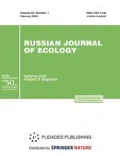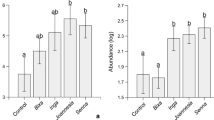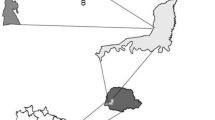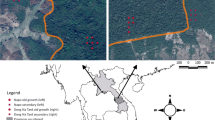Abstract
Increasing rates of deforestation in tropical forests have been linked to agriculturalists. A critical concern generating debate is how well communities of trees recover into a more species rich ecosystem after restoration planting. The aim of the study was to evaluate the pattern of recovery of communities of tree, assess the influence of Acanthus pubescens, Lantana camara and Pennisetum purpureum, on the recovery as well as how restoration planting facilitates recruitment of other native tree seedlings along a gradient of forest restoration in Kibale National Park, Uganda after evictions of illegal settlers. We studied six restoration forests ranging in age from 3 to 16 years, naturally regenerating and three primary forests. Our results showed that recovery with natural regeneration was more effective than restoration planting although the latter enhanced recruitment of other native tree seedling. Tree recovery was generally correlated with age so that species density and diversity increased although at different rates. A reverse pattern was found for dominance but no clear pattern was found for tree density (individual/ha). Communities of tree showed directional patterns of change however community composition were still distinct among the different forests. A. pubescens, L. camara and P. purpureum negatively correlated with species density, tree density and diversity but a positive correlation was found for dominance. Restoration planting can reestablish forests with high species density, tree density and diversity, but this is dependent on age and the extent of the herbs, grasses and shrubs cover in tropical forests.
Similar content being viewed by others
References
Abebe, M.H., Oba, G., Angassa, A., and Weladji, R.B., The role of area enclosures and fallow age in the restoration of plant diversity in northern Ethiopia, Afr. J. Ecol., 2006, vol. 44, pp. 507–514.
Anderson, M.J., Gorley, N.R., and Clarke, R.K., PERMANOVA+ for PRIMER: Guide to Software and Statistical Methods, Plymouth, UK: PRIMER-E Ltd., 2008.
Bowen, M.E., McAlpine, C.A., House, A.P.N., and Smith, G.C., Regrowth forests on abandoned agricultural land: A review of their habitat values for recovering forest fauna, Biol. Conserv., 2007, vol. 140, pp. 273–296.
Chapman, C.A. and Chapman, L.J., Unfavorable successional pathways and the conservation value of logged tropical forest, Biodivers. Conserv., 2004, vol. 13, pp. 2089–2105.
Chapman, C.A. and Lambert, J.E., Habitat alteration and the conservation of African primates: Case study of Kibale National Park, Uganda, Am. J. Primatol., 2000, vol. 50, pp. 169–185.
Clarke, K.R. and Gorley, R.N., PRIMER v6: User Manual/Tutorial, Plymouth, UK: PRIMER-E Ltd., 2006.
Colwell, R.K. and Coddington, J.A., Estimating the extent of terrestrial biodiversity through extrapolation, Phil. Trans. Roy. Soc. London B, 1994, vol. 345, pp. 101–118. doi 10.1098/rstb.1994.0091
Davis, A.L.V., van Aarde R.J., Scholtz, C.H., and Delport, J.H., Convergence between dung beetle assemblages of a postmining vegetational chronosequence and unmined dune forest, Restor. Ecol., 2003, vol. 11, pp. 29–42.
Duclos, V., Boudreau, S., and Chapman, C.A., Shrub cover influence on seedling growth and survival following logging of a tropical forest, Biotropica, 2013, vol. 45, pp. 419–426.
Duncan, R.S. and Chapman, C.A., Consequences of plantation harvest during tropical forest restoration in Uganda, For. Ecol. Manag., 2003, vol. 173, pp. 235–250.
Dunn, R.R., Recovery of faunal communities during tropical forest regeneration, Conserv. Biol., 2004, vol. 18, pp. 302–309.
Farwig, N., Sajita, N., and Böhning-Gaese, K., High seedling recruitment of indigenous tree species in forest plantations in Kakamega Forest, western Kenya, For. Ecol. Manag., 2009, vol. 257, pp. 143–150.
Francis, J.K. (Ed.), Wildland Shrubs of the United States and its Territories: Thamnic Descriptions, vol. 1, Gen. Tech. Rep. IITF-GTR-26, San Juan, PR: U.S. Department of Agriculture, Forest Service, International Institute of Tropical Forestry; Fort Collins, CO: U.S. Department of Agriculture, Forest Service, Rocky Mountain Research Station, 2004.
Guariguata, M.R. and Ostertag, R., Neotropical secondary forest succession: Changes in structural and functional characteristics, For. Ecol. Manag., 2001, vol. 148, pp. 185–206.
Kobayashi, S., An overview of techniques for the rehabilitation of degraded tropical forests and biodiversity conservation, Curr. Sci., 2007, vol. 93, p. 11.
Korhonen, L., Korhonen, K.T., Rautiainen, M., and Stenberg, P., Estimation of forest canopy cover: A comparison of field measurement techniques, Silva Fenn., 2006, vol. 40, pp. 577–588
Kritzinger, J.J. and van Aarde R.J., The bird communities of rehabilitating coastal dunes at Richards Bay, KwaZulu-Natal, S. Afr. J. Sci., 1998, vol. 94, pp. 71–78.
Kuper, J.H., Report on UNP-FACE Project 1996: Uganda National Parks, FACE Foundation, 1996.
Lawes, M.J. and Chapman, C.A., Does the herb Acanthus pubescens and/ or elephants suppress tree regeneration in disturbed Afrotropical forest?, For. Ecol. Manag., 2006, vol. 221, pp. 278–284.
Magurran, A.E. and McGill, B.J. (Eds.), Biological Diversity: Frontiers in Measurement and Assessment, Oxford, UK: Oxford Univ. Press, 2011.
Nyafwono, M., Valtonen, A., Nyeko, P., Owiny, A.A., and Roininen, H., Tree community composition and vegetation structure predict butterfly community recovery in a restored Afrotropical rain forest, Biodivers. Conserv., 2015, vol. 24, pp. 1473–1485. doi 10.1007/s10531-015-0870-3
Omeja, P.A., Chapman, C.A., Obua. J., Lwanga. J.S., Jacob A.L., Wanyama, F., and Mugenyi, R., Intensive tree planting facilitates tropical forest biodiversity and biomass accumulation in Kibale National Park, Uganda, For. Ecol. Manag., 2011, vol. 261, pp. 703–709.
Ormerod, S.J., Restoration in applied ecology: Editor’s introduction, J. Appl. Ecol., 2003, vol. 40, pp. 44–50.
Parrotta, J.A., Turnbull, J.W., and Jones, N., Catalyzing native forest regeneration on degraded tropical lands, For. Ecol. Manag., 2003, vol. 99, pp. 1–7.
Paul, J.R., Randle, A.M., Chapman, C.A., and Chapman, L.J., Arrested succession in logging gaps: Is tree seedling growth and survival limiting?, Afr. J. Ecol., 2004, vol. 42, pp. 245–251.
Putz, F.E., Dykstra, D.P., and Heinrich, R., Why poor logging practices persist in the tropics, Conserv. Biol., 2000, vol. 14, pp. 505–508.
Sharma, G.P. and Raghubanshi, A.S., Lantana camara L. invasion and impact on herb layer diversity and soil properties in a dry deciduous forest of India, Appl. Ecol. Environ. Res., 2011, vol. 9, no. 3, pp. 253–264.
Slocum, M.G., Aide, T.M., Zimmerman, J.K., and Navarro, L., Natural regeneration of subtropical montane forest after clearing fern thickets in the Dominican Republic, J. Trop. Ecol., 2004, vol. 20, pp. 483–486.
Struhsaker, T.T., Evaluation of the UWA–FACE Natural High Forest Rehabilitation Project in Kibale National Park, Uganda. A Report Prepared for the Centre for Applied Biodiversity Science of Conservation International and for the FACE Foundation–Conservation International, Washington, DC, 2003.
Tabuti, J.R.S., The uses, local perceptions and ecological status of 16 woody species of Gadumire Sub-county, Uganda, Biodivers. Conserv., 2007, vol. 16, pp. 1901–1915.
UWA–Face, Project Plan of Operation Report–January to December 2006, Kampala, Uganda: Uganda Wildlife Authority, 2006.
Wassenaar, T.D., van Aarde, R.J., Pimm, S.L., and Ferreira, S.M., Community convergence in disturbed subtropical dune forests, Ecology, 2005, vol. 86, pp. 655–666.
Wasserman, M.D. and Chapman, C.A., Determinants of colobine monkey abundance: The importance of food energy, protein and fibre content, J. Anim. Ecol., 2003, vol. 72, pp. 650–659.
Wright, S.J. and Muller-Landau, H.C., The future of tropical forest species, Biotropica, 2006, vol. 38, pp. 287–301.
Author information
Authors and Affiliations
Corresponding author
Additional information
The article is published in the original.
Rights and permissions
About this article
Cite this article
Owiny, A.A. Communities of trees along a tropical forest restoration gradient. Russ J Ecol 47, 53–61 (2016). https://doi.org/10.1134/S1067413616010094
Received:
Published:
Issue Date:
DOI: https://doi.org/10.1134/S1067413616010094




